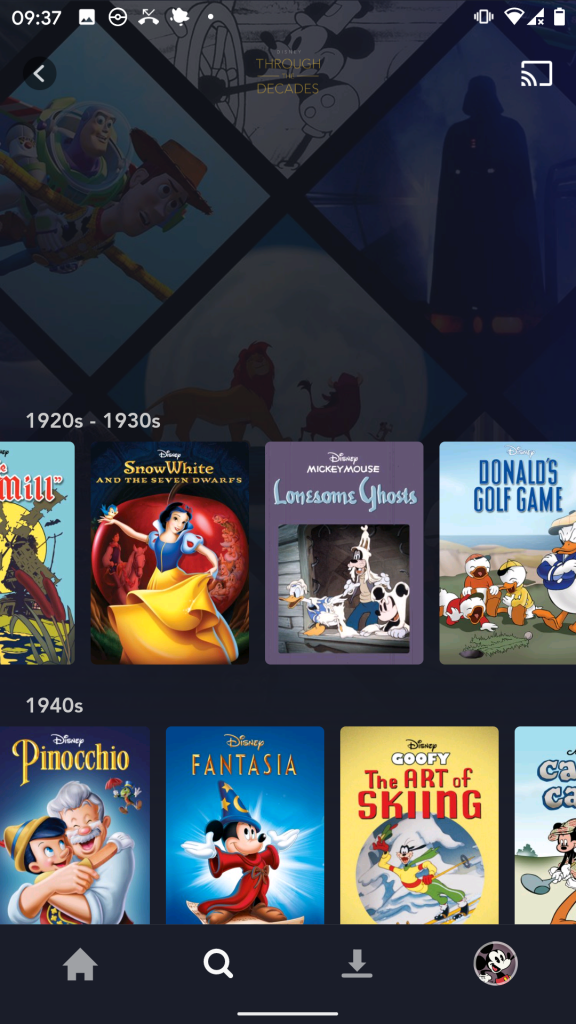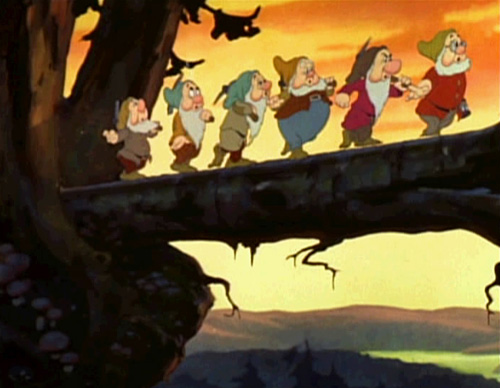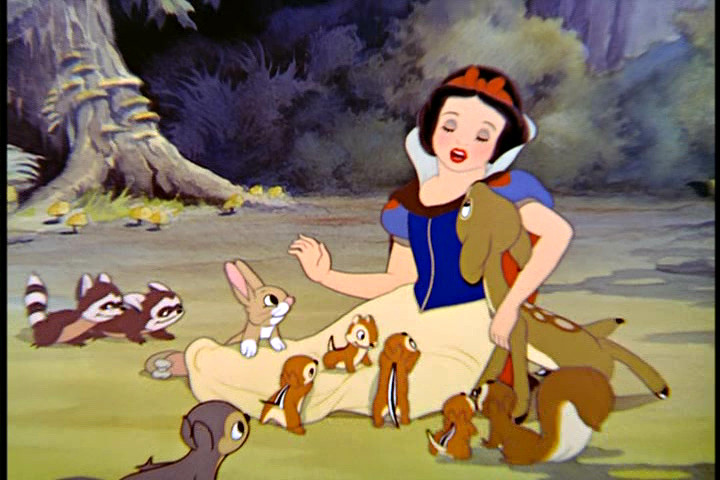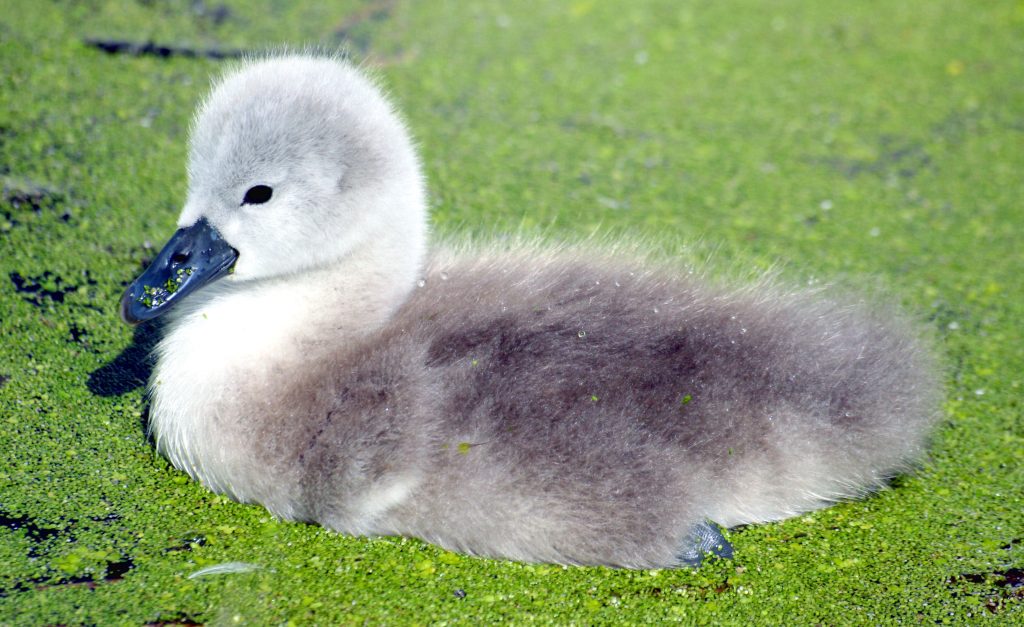In this post, I will finish the first part of ‘Through the Decades’ leaving behind the 1930’s.

To begin with, I wanted to review some aspects of the app itself! I have found a few fault with the new app.
The first issue many fans will notice with Disney+ is that the app has removed a majority of the bonus materials associated with all the Disney movies. This means you cannot discover how the films were created. By comparison, DisneyLife, and the DVD releases included all the behind the scenes features. I first noticed the lack of material whilst going through the decades and watching Snow White. I was shocked to see there is scarcely any material regarding the making of Snow White. Here’s hoping more material will be added with time. Most likely Disney pulled most bonus material in the hopes of launching more content under a higher paid subscription in the future.
Alongside the Through the Decades marathon I decided to test out different content from this new Disney service. I was surprised to find the Marvel film universe had not been placed into the agreed Phases one, Two and Three from the established universe. Furthermore, The Simpsons has suffered from new aspect ratio. As there’s already a bombardment of comments about, The Simpsons on Disney+ online, so I won’t waste much time on this topic.
On a positive note Disney+ has incorporated an autoplay function which works well for binge watching TV shows like The Simpsons. Sadly, the autoplay option is not yet as intuitive as the Netflix autoplay option. For example, Disney+ will just keep playing the next episode automatically from a TV show. Don’t fall asleep in front of the TV unless you want to miss a few seasons of your favourite show.
My last criticism regards the subtitle option on the app. Let me begin by saying the language options on Disney+ work seamlessly especially in comparison with DisneyLife. However, the subtitles option are terrible. The subtitles appear in dark blocks that distract from the picture. Shouldn’t this option be more seamless for the audience users with hard of hearing?
Anyway enough of me nitpicking. I will now resume the Disney Through the Decades.

The Three Blind Mouseketeers 1936
We kickstart this next part of our Disney binge with The Three Blind Mouseketeers. The story is a mixture of the nursery rhyme three blind mice and the three musketeers. The basic plotline involves three mice unwittingly trying to survive the traps of the evil guard Katt; (who is an animated mixture between Lucifer and Pete).
Of the many Silly Symphony’s available on Disney+, this one isn’t particularly memorable. Whilst the short is not bad by any means, it is just a little uninspired when compared to predecessors. There are some nice gags: the mice use their swords as a walking stick but it quickly gets dull. The animation has improved considerably. The mice look… well… more like mice. It is clear that some jokes in this short are going to be used later on for feature films; e.g. the same gag is used in Cinderella where the mice are hiding under bowls.
Sidenote: Why are so many villains fat in the Silly Symphony’s? Perhaps, this is this just my assumption, let me know what you guys think.
Mickey’s Rival 1936

A little history lesson can add some important context to this film. Walt Disney was originally going to name his iconic mouse, Mortimer. There are two stories that claim to be the reasons as to why Mortimer was changed to Mickey. One involved Mickey Rooney meeting Walt as a child, whilst another involves his wife, Lillian, encouraging him to do so. In this film, we see Mickey’s rival, aptly named Mortimer, make his first appearance.
The story involves Minnie’s old friend, Mortimer, gatecrashing her date with Mickey. Mortimer attempts to flirt with Minnie, whilst also playing a set of tricks on Mickey. However, when a bull runs to attack the picnic, it is Mickey who must rescue Minnie as Mortimer flees the scene. By showing how courageous and loveable Mickey is the audience can easily detest Mortimer. By comparison, Mortimer is a bully with no feelings for Minnie.
In terms of animation style, it is interesting to see how Minnie’s signature look was the hat and flower for many years before it became the bow.
Thru The Looking Glass 1936
Mickey dreams of entering the world through the looking glass after reading Alice Through The Looking Glass. Many of the fantasy elements in the mirror world will be used later on in the 1950’s feature film Alice in Wonderland. Fantasy is what makes this film particularly enjoyable. For example, the nutcracker who eats the nuts it is cracking, or the telephone who talks to itself.
Another interesting aspect to the film is the glimpse the audience has into the 1930s home. Mickey owns many old household technologies such as the enormous radio, or the candlestick telephone. Whilst a majority of the film involves Mickey dancing it is still enjoyable to watch.
Toby the Tortoise Returns 1936
So, it turns out Disney was making sequels long before The Lion King created a second instalment. This is the third sequel in the current Disney+ binge. The film also has several character crossovers from previous Silly Symphony’s.
This time Toby the Tortoise faces Max the Hare in an unfair boxing match. Interestingly, the pig who is refereeing the match is the practical pig from the Three Little Pigs. Among the other character’s seen in the film are the brother pigs in the audience. Another, character cameo is Jenny Wren (a Mae West-Esque bird) from Who Killed Cock Robin. Sidenote: The film Who Killed Cock Robin is not included on Disney+. I am unsure if this is the first crossover in the Silly Symphony’s films, if anyone does know please let me know in the comments below.
Hawaiin Holiday 1937
This is the first time on Disney+ the audience will see the main Disney ensemble. This includes Goofy, Donald, Pluto, Minnie and Mickey. The short involves Mickey and his friends enjoying the beach by surfing and hula dancing. In general, the Mickey short films work better with a wider variety of character’s who offer more gimmicks. For example Goofy being clumsy or Donald losing his temper. However, this film falls a little flat on entertainment despite the range of characters.
Clock Cleaners 1937
The dream team; Mickey Mouse, Donald Duck and Goofy are together once more in this humorous animated short.
The story involves the trio cleaning a clock tower and facing many issues in the process. One particularly stressful scene is when Goofy almost plummets off the tower. In terms of the animation, I find it strange that Donald and Goofy have eyes but Mickey’s are just black dots.
The gags are finally getting better thus it is becoming fun to watch Mickey films. Unlike the previous short this one manages to be funny and gripping all at once. I have a personal preference for Donald Duck and his short temper which may be why this short felt more engaging. Donald really delivers on the comedy in this short.
The Old Mill 1937
This film is certainly not character-driven. Indeed this short works more like something out of a Fantasia segment. What makes the film worth viewing is the detailed animation of the opulent music. The Silly Symphony shows an old mill that is inhabited by animals, who go through a turbulent rainstorm.

This film was used for testing backdrops and special effects like the animation of the rain and storms. The style is different from previous Silly Symphony’s using dark colours/tones in comparison to the very bright colours in earlier films.
Snow White and the Seven Dwarfs 1937
The one that started it all! This is the first-ever feature-length animated movie. Please excuse my enthusiasm as I delve into some brief history of the movie.
Snow White was in development for three years and was met with severe scepticism during production. Stakeholders believed audiences would not respond well to watching animation for over an hour, many critics argued the bright colours would hurt their eyes. As such, the project became known as Walt Disney’s Folly.
New technologies were created, such as the multiplane camera, allowing several images to be superposed on top of each other, creating more depth from the backdrops. The production was so expensive for the company that Walt remortgaged his own home. Nevertheless, Walt knew his project was worth the hard labour. Several plot developments paved the way for the success of the movie: one clear point was Walt’s decision to give the dwarfs different personalities, which wasn’t included in the Brothers Grimm fairy tale.

When the film was released in 1937, Snow White became an immediate success. Critics found themselves crying at the end of the movie at this fictional princess lying in a glass coffin. One can only imagine the awe from cinemagoers of the time. One may be able to draw some similarities between the first CGI movies like Toy Story. Thanks to Snow White we have not only Disney films but the creation of animated films as a medium.
It has withstood the test of time with merchandise still being sold to this day. However, I wonder how younger audiences fare with this movie. As a child, the movie failed to grab my attention as much as, Cinderella or The Little Mermaid, it was only as an adult I really came to love this film. Perhaps, it is from discovering the history involved in creating the Disney empire. It just adds a real sense of importance to the movie and to Snow White legacy. When watching the film it feels like your watching a moving painting. After watching the Silly Symphony’s beforehand the animation has advanced beyond recognition.
One small criticism I have about the movie is Snow’s voice. Her singing always felt pitchy to me. It is worth pointing out this also only applies to the English version. Walt wanted this child-like quality to the voice but to me, it sounds more like a screechy granny when she sings. Having watched the film in different languages, i.e French, she has a smoother tone that matches all other princesses in the Disney lineup. However, I do like Snow White’s character. She has a such a gentle disposition not matched with other princesses. I also love the way she moves around so theatrically. Snow White has a real queerness about her that is also so pure. Many new cinema-goers claim she is a bad role model but I have to disagree. Snow is rather resourceful, given she is meant to be 14, she finds her way to a cottage after nearly being assassinated and finds a way to earn her keep. Furthermore, she enforces her authority over the dwarfs insisting the must wash there hands before supper. This seems particularly relevant during the COVID-19 pandemic.

What dates the film is the lengthy amount of time wasted on animated gags, particularly with the animals and dwarfs. This is reflective of special effects that become overused in recent cinema. The reason for the lengthy amount of gags can be linked to the animators who would receive around 5 dollars per gag that was used in the final film, (five dollars is an equivalent of about 89 dollars today).
Ok, let me finish on my favourite topic villains. The Evil Queen is just the epitome of evil and she has a great duality about her. She begins the film with a regal voice and a fierce persona. Then she ascends into a terrifying crone. The crone actually scared the hell out of me as a child. As an adult, you can enjoy her wicked laughs and her vindictive streak. A good example is how she taunts a skeleton of a prisoner trying the reach for water. My all-time favourite scene is when Snow White is making Grumpys pie and she jumps when she finds the crone is at the window. One can only imagine the genuine horror if you found the wicked crone at your window.
The Lonesome Ghosts 1937
Mickey, Goofy and Donald are called to exterminate ghosts. Unknown to them the call was made by real phantoms who are bored in a haunted mansion. The ghosts proceed to play pranks on the trio when they arrive. The short is enjoyable to watch though there is not much to report on animation style.
Donald’s Golf Game 1937
Disney+ error number 2. I will have to go on a slight tangent by stating how disappointed I am that Disney+ did not include the film Donald’s Nephews in their lineup. Especially as it was on DisneyLife. Donald’s Nephews is an important film because it introduced Huey, Dewey and Louie, and it is also a funny film. Hopefully, Disney+ will add more content in the future. Regardless, Donald’s Golf Game is equally enjoyable, Donald Duck is my favourite Disney character so perhaps I am being biased in my reviews.
The film starts with a happy Donald, who is setting up to play golf with his nephews. Predictably, he gets irritable quickly because he keeps missing his shot, either due to the birds making a racket or his nephews. In anger, he tries to peg there beaks shut causing his nephews to seek revenge. If you’re like me you may feel bad for Donald, he is just trying to have fun, but he keeps getting pranked.
Huey, Dewey and Louie, are drawn to look very adorable despite being super mischievous during the early incarnations. Overall, the animation is very impressive. Indeed, the duck’s expressions show the characters and temperament. I actually laughed aloud a few times whilst watching this film which shows it is still relatable. The moral of any Donald film is just try to keep your cool.
Mickey’s Trailer 1938
The trio returns! This time they are travelling in across the country in a mobile home. The mobile home is really the personality of this short. Everything just opens up and folds away magically like its part of wacky inventors house. This includes blow up bathtubs and foldaway bedsides.
I am still unsure why Mickey retained his two black dots eyes for so long. Nevertheless, the animation has definitely improved. The gags have also gotten better, as a result, the humour is more organic.
Sidenote: When the mobile home is falling down the cliff why does Donald ring for the operator? Did the number 911 not exist in the USA in the ’30s? Let me know in the comments below if you have the answer.
Mickey Mouse in Boat Builders 1938
In this film, the trio attempts to build there own boat from scratch. Whilst the short is enjoyable there is nothing new to capture the audience. There are no major changes in the animation style. The issue with the Mickey cartoons is they can be a tad repetitive this felt like a less impressive re-hash of Clock Cleaners. It is still enjoyable but the shorts really all meld together when watched consecutively. This is possibly due to that fact these films were never intended to be binge-watched.
Ferdinand and The Bull 1938
Ferdinand is a gentle-spirited bull who does not want to fight he just wants to smell flowers. Then one day he accidentally sits on a bumblebee and the townspeople think he is a ferocious bullfighter. As a result, he is forced into bullfighting, to the bullfighter’s dismay, Ferdinand is only interested in smelling the flower tattoo on his chest.
I had never seen this film before and this was a sheer delight to discover. The story is narrated throughout, and it is rather witty at times. I rather liked the line where the narrator states “His mother was understanding even though she was a cow.” The moral of the story teaches us that someone can be different despite appearances or background. This is a moral that is especially important to me given that this story tackles the pressures of stereotypical masculinity.
The animation is also very cute I enjoyed the fact Ferdinand has long lashes. The humans finally have more defining features and no longer have comic potato noses.
Donald Duck Beach Picnic 1939
Donald plays pranks on poor Pluto at the beach. However, he soon gets a taste of his own medicine when the ant colony takes away his picnic lunch. The short is fun to watch because Pluto and Donald are characterised by there short temper. Therefore, they are able to bounce off each other.
One small thing I noticed was the red ants appear to be tribal. Are they meant to be native Americans? The music would indicate they are an indigenous tribe of sorts.
The Hockey Camp 1939
Hewey, Duey and Louis return.
In this short Donald tries to show his nephews how to play Hockey and is ultimately outdone by his nephews. I personally enjoyed that Donald starts the film envisioning himself as a female ice skater. It is also nice to see animation set in the winter, most shorts featured on Disney+ prior to this have all been prominently set in spring/summer.
Society Dog Show 1939

Mickey has entered Pluto ins a Society Dog Show. Unfortunately, Pluto’s pedigree doesn’t match the high-class breeds he must compete with. I always found Pluto was rather ugly so when he is asked to leave the show it does not surprise me. Indeed, the joke when someone asks “what type of dog is he?” feels rather relevant. This particular Mickey/ Pluto film is rather endearing, both Mickey and Pluto are looked down on by the high class but they retain a cheery attitude.
The Ugly Duckling 1939
We end the first section of the Through the Decades binge (20’s to ’30s), with a Silly Symphony, and it is a good place to end. The film is based on Hans Christain’s Ugly Duckling, a story which speaks to the outcasts of the world.

The story opens with the birth of new ducklings. All of them are adorable yellow ducklings except one who is a white duckling. As a result, the mother duck proceeds to reject the duckling from her family. The mother is pretty horrible in this film aggressively chasing of the duckling. It creates a great sense of empathy for the hero. By the time the duckling look’s at his reflection and cries you feel rather emotional. A sign of good storytelling. Thankfully, the film soon turns happy when the duckling learns he belongs to a swan family. It is the type of happy ending that is quintessentially Disney.

Be First to Comment